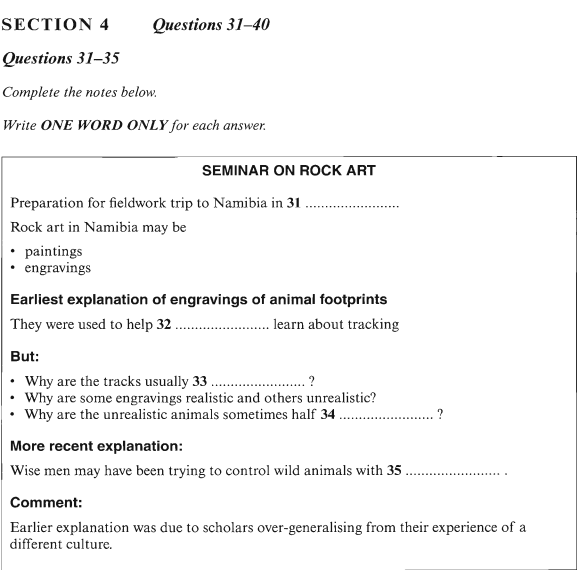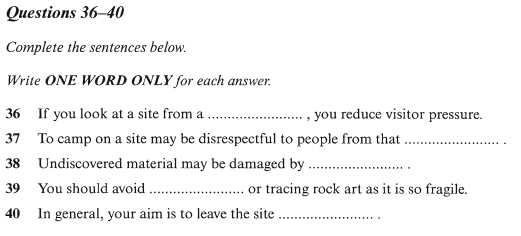剑桥雅思7听力:Test1雅思听力Section4真题及解析
发布时间:2020-11-12 关键词:剑桥雅思7听力:Test1雅思听力Section4真题及解析为帮助同学们学习,小编为大家整理了剑桥雅思7听力:Test1雅思听力Section4真题及解析,希望能够对大家有帮助。关于剑桥雅思的资讯关注新航道北京学校剑桥雅思栏目。
SECTION 4
Good afternoon, everyone!
This is the first seminar in preparation for our archaeological fieldwork in Namibia; we arefantastically lucky to have received partial research funding for this trip from our Institute,so I shall expect 200% attention and participation from you all. First in this seminar, I'mgoing to give a brief introduction to contemporary research on rock art, and in the secondpart I'm going to give you some do's and don'ts for our fieldwork trip in April - so pleaselisten very carefully,
I'm first going to focus on the interpretation of rock art in Namibia. We are very fortunate tobe going to an area where you can find some of the most important sites in the entire world.And I hope to show you how easy it is for everyone to make mistakes in looking at cultureswhich are different from our own - the first and most important lesson we have to learn.
In Namibia there are both paintings and engravings - that's where the surface of the rock iscut out. Many of the engravings show footprints of animals and most scholars used to thinkthat the purpose of these was simple and obvious: this rock art was like a school book withpictures to teach children about tracks: which track belonged to which animal - giraffe, lion (and so on.
But there were some mysteries. First, when you look at a typical Namibian painting orengraving, you see the tracks are repeated, there are dozens of tracks for the same animal.You'd expect just one clear illustration if the reason - the aim - was to teach tracking.
Now there were two more problems. Why are some of the engravings of animals very accurateas you'd expect - all clearly identifable - and others quite unrealistic?
And another mystery - some of these unrealistic animals - that's in the engravings - seemto be half human. Some, for example, have got human faces. Many researchers now thinkthat these were pictures the wise men engraved of themselves. They believed they could usemagic to control the animals they had drawn, so the hunters could then catch them for food.
This shows you some of the dangers of coming from one culture to another, as we'll bedoing, without understanding it fully. Scholars imagined that children looked at rock art
pictures to learn to track - just because they themselves had learnt skills from pictures; manyresearchers now believe that rock art had a much more complex purpose. And we'll talk moreabout it next week!
Now before I invite you to join in a discussion in this second part of the seminar, I'd like tomake some very important points about our fieldwork - and in fact any field trip to look atrock art.
We're going to a number of sites, and we won't always be together. The single largest problemfaced by people who manage the sites is - yes, I'm sure you' ve guessed - damage caused byvisitors, even though it's usually unintentional.
Whenever you do go to a site, don't forget you can learn many things from observing at adistance instead of walking all over it. This can really help to reduce visitor pressure. Peopleoften say, 'Well, there's only two of us and just this one time', but maybe thousands of
people are saying the same thing.
And then some basic rules to guide you - we'll have our own camp near a village, butremember never to camp on a site if you go on your own. It may be disrespectful to thepeople of that culture, and certainly don't make fires, however romantic it may seem. It'sreally dangerous in dry areas, and you can easily burn priceless undiscovered material bydoing so.
So, how are we going to enjoy the rock art on our field trip? By looking at it, drawing it andphotographing it - NEVER by touching it or even tracing it. Rock art is fragile and precious.
Remember that climbing on rocks and in caves can destroy in a moment what has lasted forcenturies. So no heroics in Namibia, please! Try to be extra careful and help others to be too.
And lastly please don't even move rocks or branches to take photographs - you should leavethe site intact - I'm sure I can rely on you to do that.
Well, that's about all I want to say before today's first discussion, but if you have any
questions please ask them now - and don't forget you'll find some fascinating informationabout world-wide sites on the Internet. Right, first question then?
第四节
大家下午好!
这是为我们在纳米比亚的考古实地工作做准备的次研讨会;幸运的是,我们得到了学院为这次旅行提供的部分研究经费,希望大家能以200%的热情关注和参与。首先,在这次研讨会上,我将简要介绍当代岩石艺术研究的情况,第二部分,我将给大家介绍我们四月份实地考察的一些注意事项,所以请大家仔细阅读,
我首先要讲的是纳米比亚的岩石艺术。我们幸运地要去一个你能找到世界上最重要的一些景点的地方。我希望向你们展示,对于每个人来说,在看待不同于我们自己的文化时犯错误是多么容易——这是我们必须学习的个也是最重要的一课。
在纳米比亚有绘画和雕刻——那是岩石表面被切割出来的地方。许多石刻上有动物的脚印,大多数学者过去认为,这些石刻的目的很简单,也很明显:这种岩石艺术就像一本带图画的教科书,用来教孩子们关于脚印的知识:哪条脚印属于哪一种动物——长颈鹿、狮子(等等)。
但也有一些谜团。首先,当你看一幅典型的纳米比亚绘画时,你会看到重复的足迹,有几十条足迹都是同一只动物留下的。如果目的是为了教学生跟踪,你只需要一个清晰的说明。
现在又有两个问题了。为什么有些动物的雕刻如你所料的那样精确——都很清楚地可辨认——而另一些却很不现实?
另一个神秘之处是,雕刻的这些不真实的动物中,有一些似乎是半人半兽。例如,有些人有人脸。许多研究人员现在认为这些画是智者为自己刻的。他们相信他们可以用魔法来控制他们画的动物,这样狩猎者就可以捕获它们作为食物。
这向你展示了一些从一种文化到另一种文化的危险,就像我们将要做的,没有完全理解它。学者们以为孩子们在看岩石艺术
通过图片来学习跟踪——因为他们自己已经从图片中学到了技巧;许多研究人员现在相信岩石艺术有一个更复杂的目的。我们下周再详细讨论!
现在,在我邀请你们参加研讨会第二部分的讨论之前,我想就我们的野外工作——以及任何考察岩石艺术的野外旅行——提出一些重要的观点。
我们会去地方,我们不会一直在一起。管理网站的人所面临的的问题是——是的,我相信你已经猜到了——由访问者造成的损害,即使它通常是无意的。
无论你什么时候去一个景点,别忘了你可以从远处观察学到东西,而不是到处走。这可以真正帮助减少游客的压力。人们常说,‘好吧,我们只有两个人,就这一次’,但可能有几千人
人们都在说同样的话。
然后是一些基本的规则来指导你——我们会在村庄附近有我们自己的营地,但是记住,如果你一个人去,永远不要在一个地点露营。这可能是对那个文化的人的不尊重,当然也不要生火,尽管看起来很浪漫。在干燥的地区,这是危险的,这样你可以很容易地烧掉未被发现的无价的材料。
那么,在我们的野外考察旅行中,我们要如何欣赏岩石艺术呢?通过观察它,绘制它,拍摄它——而不是触摸它,甚至描摹它。岩石艺术是脆弱而珍贵的。
请记住,在岩石上或洞穴里攀爬会在一瞬间摧毁延续了几个世纪的一切。所以在纳米比亚请不要逞英雄!要格外小心,帮助别人也一样。
最后,请不要为了拍照而移动岩石或树枝——你应该保持遗址完好无损——我相信你能做到这一点。
好了,这就是今天次讨论之前我想说的,如果你们有任何想法的话
现在就问他们问题吧——别忘了你会在互联网上找到一些关于世界各地网站的有趣信息。好,个问题?
师资点题剑桥雅思7听力:
Test 1 LISTENING
SECTION 4


场景介绍
主题:一个介绍岩洞绘画和各种岩石艺术类型的讲座
师资点题剑桥雅思7听力:
题型介绍
题号 31-35 36-40
题型 笔记填空题 单句填空题
测试技能 倾听具体信息
考题精解
Question 31 April
从试卷已给出的信息分析,此处要具体锁定的答案信息为时间,当录音中讲座者介绍说 … I’m going to give you some do’s and don’ts for our fieldwork trip in April … 可以确定答案为April。月份为专有名词,首字母大写。
Question 32 children
从试卷已给出的信息分析,此处要具体锁定的答案信息为名词,表示一类人。当录音中讲座者介绍说... this rock art was like a school book with pictures to teach children about tracks ... 答案锁定为children。
Question 33 repeated
从试卷已给出的信息分析,此处要具体锁定的答案信息为动词的被动语态结构。试卷上but后是并列的三个问题,此题是第1个问题,当录音中讲座者介绍说 ... first,when you … 考生应有所警觉,第33题的答案即将出现,接着,讲座者介绍说you see the tracks are repeated ... 对应试卷上已经出现的信息,确定答案为repeated。
Question 34 human
从试卷已给出的信息分析,此处要具体锁定的答案信息为被half所修饰的名词。当录音中讲座者介绍说and another mystery ...,预示着新的问题出现,接着讲座者介绍说 ... that’s in the engravings — seem to be half human,答案确定为 human。
Question 35 magic
从试卷已给出的信息分析,此处要具体锁定的答案信息为名词。当录音中讲座者提到 ... they believed they could use magic to control the animals they had drawn,对应试卷上已出现的信息,答案确定为magic。
Question 36 distance
从试卷已给出的信息分析,此处要具体锁定的答案信息为单数可数名词。当听到录音中讲座者介绍说 … you can learn many things from observing at a distance instead of walking all over it. This can really help to reduce visitor pressure。对应试卷上已出现的信息,observe对应试卷上的look at,答案确定为distance。
Question 37 culture
从试卷已给出的信息分析,此处要具体锁定的答案信息为名词。当录音中讲座者说It may be disrespectful to the people of that culture,对应试卷已经给出的信息,答案确定为 culture。
Questions 38 fire (s)
在说完第37题后,讲座紧接着介绍说and certainly don’t make fires, … It’s really dangerous in dry areas and you can easily bum priceless undiscovered material by doing so。对应试卷上此题已给出的信息,确定答案为fires。
Questions 39 touching
从试卷已给出的信息分析,此处要具体锁定的答案信息为动词,但空前的信息为avoid,avoid后面要跟doing something,所以要注意答案的准确度。录音中讲座者提到要By looking at it, drawing it and photographing it — never by touching it or even tracing it,对应试卷上已出现的信息,答案确定为touching。
Questions 40 intact
从试卷已给出的信息分析,此处要具体锁定的答案信息为某种状态。当录音中讲座者介绍说 … don’t even move rocks or branches to take photographs — you should leave the site intact … 对应试卷上已出现的信息,答案确定为intact。




